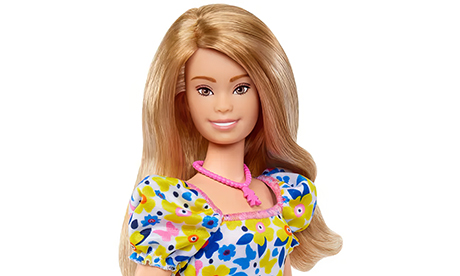Recently, my husband repurposed a piece of plastic, some string and a scrap of fabric to make a therapy swing for my daughter’s Barbie dolls.
My daughter Josie has Down syndrome and attends a therapy centre where she works on her speech and her fine and gross motor skills.
She loves being pushed on a swing there by her favourite therapist, Ms Lani.
So it only makes sense that when my daughter plays with her Barbie dolls, she re-enacts her favourite moments at the therapy centre with her new therapy swing and an Anna doll (from the film “Frozen”) representing Ms Lani—Anna and Lani share the same ginger hair colour.
Wouldn’t it be wonderful if the doll my daughter uses to represent herself could reflect her own unique features, including a shorter stature, a flat nasal bridge and beautiful almond-shaped eyes?
This will soon be possible because Mattel has released a new Barbie doll with Down syndrome.
Mattel worked with the National Down Syndrome Society to ensure that the new doll would accurately represent the members of this community.
“It was an honour working with Barbie on the Barbie doll with Down syndrome,” Kandi Pickard, the president and C.E.O. of N.D.S.S., said.
“This means so much for our community, who for the first time, can play with a Barbie doll that looks like them.”
Our family is unique in that it encompasses two generations of Down syndrome.
My sister, Leanne, was born in 1977.
She required life-saving surgery to survive.
My parents were offered the option to forgo the surgery, forget about this ailing child and try again for a healthy child.
As a devout Catholic, my mother rejected this notion.
This was her baby, made in God’s image.
Leanne was a blessing—one for whom she was incredibly grateful and committed to nurturing with every fibre of her being.
Growing up with my sister was such a positive experience for me that when it came time for me to start a family, I truly wanted to adopt a baby with Down syndrome.
That dream was realized in 2010.
The 33-year age difference between my sister and my daughter brought many beneficial changes in resources and attitudes toward the Down syndrome population.
I’ll never forget my mom marvelling at how much more access my daughter had to therapists, adaptive equipment, educators and medical professionals who were committed to promoting her development.
When my daughter was fitted with her first pair of orthotics, braces designed to correct her pronation and stabilise her foot and ankle, my mom reminisced about how they attempted to achieve the same result with Leanne by having her sleep in high-top shoes tied together.
Orthotics are an accessory featured on the new Barbie with Down syndrome, another testimony to the progress achieved within the last 30 years.
What was not accessible to my sister then is now present on the Barbie!
The doll’s dress features butterflies in yellow and blue print—symbols and colours associated with Down syndrome awareness.
The doll wears a necklace with a pendant featuring three chevrons, designed to symbolize the three copies of the 21st chromosome that causes Down syndrome, hence its name, Trisomy 21. Continue reading
- Elizabeth Newton is an advocate, writer, and speaker. She writes on ConfessionsoftheChromosomallyEnhanced.com
News category: Analysis and Comment.




